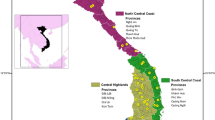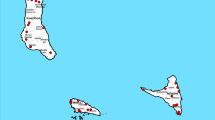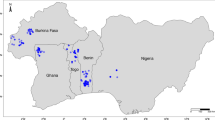Abstract
To develop a strategy for improvement of cassava (Manihot esculenta Crantz) productivity for climate change preparedness in Lamu County, Kenya, it was important to understand which cultivars farmers are growing. Landraces should be collected and conserved prior to replacement by improved cultivars to avoid erosion of genetic resources and associated farmer knowledge. In this study, 58 samples of landraces were collected from five administrative wards in Lamu County. These were SNP genotyped using low-density Diversity Array Technologies (DArT) DaRTSeq™ together with a reference set of 48 breeding lines, eight coastal and 45 inland landraces to aid identification of the collected samples. Genotyping results defined nine clades of duplicates and six unique clones. The most representative clone was selected from each clade of duplicates and combined with the unique clones giving a set of 15 different genotypes. None of the landraces or improved cultivars used in the reference panel were found in the genotyped collection. Discriminant Analysis of Principal Components revealed four clusters; Lamu germplasm, breeding lines, inland landraces and coastal landraces with low levels of differentiation between them. According to Wrights’ F Statistics landraces from Lamu were most closely related to other coastal landraces (Fst = 0.0300), with greater differentiation from breeding lines (Fst = 0.0578) and inland landraces (Fst = 0.0632). Expected heterozygosity was highest for the breeding lines (0.275) and lowest for Lamu landraces (0.240), indicating a narrow genetic base. The results provide valuable information on genetic diversity and identify germplasm for conservation and future use.





Similar content being viewed by others
References
Adamack AT, Gruber B (2014) PopGenReport: simplifying basic population genetic analyses in R. Methods Ecol Evol 5:384–387
Agre AP, Bhattacharjee R, Rabbi IY, Alaba OY, Unachukwu NN, Ayenan MAT et al (2017) Classification of elite cassava cultivars (Manihot esculenta Crantz) cultivated in Benin Republic using farmers’ knowledge, morphological traits and simple sequence repeat (SSR) markers. Genetic Resour Crop Evol 64:307–320
Albuquerque HYGD, Oliveira EJD, Brito AC, Andrade LRBD, Carmo CDD, Morgante CV et al (2019) Identification of duplicates in cassava germplasm banks based on single-nucleotide polymorphisms (SNPs). Sci Agric 2019(76):328–336
Asare AP, Galyon IKA, Sarfo KK, Tetteh JP (2011) Morphological and molecular based diversity studies of some cassava (Manihot esculenta Crantz) germplasm in Ghana. Afr J Biotechnol 10:13900–13908
Ceballos H, de la Cruz GA (2002) Taxonomy and morphology of cassava. OSPINA, Bernardo and CEBALLOS, Hernán. Cassava in the Third Millennium, pp. 16–31
Cox TP, Nakabonge G, Ferguson M (2014) Manual for collection of cassava germplasm and associated farmer knowledge in Eastern and Southern Africa. Nigeria, Ibadan, IITA, 2014
Edoh NL, Adiele J, Ndukwe I, Ogbokiri H, Njoku DN, Egesi CN (2016) Evaluation of high beta carotene cassava genotypes at advanced trial in Nigeria. In: The open conference proceedings Journal 2016 Dec 13 (vol 7, No 1)
Elias M, McKey D, Panaud O, Anstett MC, Robert T (2001) Traditional management of cassava morphological and genetic diversity by the Makushi Amerindians (Guyana, South America): perspectives for on-farm conservation of crop genetic resources. Euphytica 120:143–157
FAO (2018). http://www.fao.org/faostat/en/#data/QC. Accessed 2nd October 2022
Ferguson ME, Shah T, Kulakow P, Ceballos H (2019) A global overview of cassava genetic diversity. PLoS ONE 14(11):e0224763
Ferguson ME, Tumwegamire S, Chidzanga C, Shah T, Mtunda K, Kulembeka H et al (2021) Collection, genotyping and virus elimination of cassava landraces from Tanzania and documentation of farmer knowledge. PLoS ONE 16(8):e0255326. https://doi.org/10.1371/journal.pone.0255326
Ferguson M, Choti A, Munguti F (2020) Virus elimination and testing in cassava: a practical manual. Ibadan, Nigeria: IITA, pp 24
Fukuda WMG, Guevara CL, Kawuki R, Ferguson ME (2010) Selected morphological and agronomic descriptors for the characterization of cassava. Ibadan: Nigeria IITA, 19
GoK (Government of Kenya) (2019) 2019 Kenya Population and Housing Census: Volume I: Population by County and Sub-County; ISBN: 978-9966-102-09-6; Government Printers, Nairobi
GoK (2013) County Development Profile (CDP) for Lamu, Ministry of Devolution and Planning, Government Printers, Nairobi, Kenya
Goudet J, Jombart T (2015) Hierfstat: estimation and tests of hierarchical F-statistics
Gruber B, Unmack PJ, Berry OF, Georges A (2018) Dartr: an r package to facilitate analysis of SNP data generated from reduced representation genome sequencing. Mol Ecol Resour 18:691–699
Gwali S, Okullo JBL, Eilu G, Nakabonge G, Nyeko P, Vuzi P (2011) Traditional management and conservation of Shea trees (Vitellaria paradoxa subspecies nilotica) in Uganda. Environ Dev Sustain 14(3):347–363
Iragaba P, Tufan HA, Kawuki RS et al (2020) Genomic characterization of Ugandan smallholder farmer-preferred cassava cultivars. Crop Sci 60:1450–1461
Jennings D (1957) Further studies in breeding cassava for virus resistance. East Afr Agric J 22:213–219
MOALF (2015) Agriculture Sector Development Support Programme (ASDSP), Annual work plan and budget
Mtunguja MK, Laswai HS, Muzanila YC, Ndunguru J (2014) Farmers knowledge on selection and conservation of cassava (Manihot esculenta) genetic resources in Tanzania. J. Biol Agric Healthcare 4:120–129
Munganyinka E, Ateka EM, Kihurani AW, Kanyange MC, Tairo F, Sseruwagi P et al (2018) Cassava brown streak disease in Rwanda, the associated viruses and disease phenotypes. Plant Pathol 67:377–387
Nakabonge G, Samukoya C, Baguma Y (2018) Local cultivars of cassava: conservation, cultivation and use in Uganda. Environ Dev Sustain 20:2427–2445
Ndung’u JN, Wachira FN, Kinyua MG, Lelgut DK, Njau P, Okwaro H, Obiero H (2014) Genetic diversity study of Kenyan cassava germplasm using simple sequence repeats. Afr J Biot 13(8):926–935
Njoku DN, Vernon G, Egesi CN, Asante I, Offei SK, Okogbenin E, Kulakow P, Eke-Okoro ON, Ceballos H (2011) Breeding for enhanced β-carotene content in cassava: constraints and accomplishments. J Crop Improv 25(5):560–571
Nyirakanani C, Pierre BJ, Yves K et al (2021) Farmer and field survey in cassava-growing districts of Rwanda reveals key factors associated with cassava brown streak disease incidence and cassava productivity. Front Sustain Food Syst 5:1–14
Phosaengsri W, Banterng P, Vorasoot N, Jogloy S, Theerakulpisut P (2019) Leaf performances of cassava genotypes in different seasons and its relationship with biomass. Turkish J Field Crops 24:54–64
Pierre N, Wamalwa LN, Muiru WM, Simon B, Kanju E, Ferguson ME et al (2022) Genetic diversity of local and introduced cassava germplasm in Burundi using DArTseq molecular analyses. PLoS ONE 17(1):e0256002. https://doi.org/10.1371/journal.pone.0256002
R Core Team (2018) R: A language and environment for statistical computing. R Foundation for Statistical Computing, Vienna, Austria. 2018. https://www.R-project.org
Rabbi IY, Kulakow PA, Manu-Aduening JA, Dankyi AA, Asibuo JY, Parkes EY, Abdoulaye T, Girma G, Gedil MA, Ramu P, Reyes B (2015) Tracking crop varieties using genotyping-by-sequencing markers: a case study using cassava (Manihot esculenta Crantz). BMC Genet 16(1):1–11
Tumwegamire S, Kanju E, Legg J et al (2018) Exchanging and managing in-vitro elite germplasm to combat cassava brown streak disease (CBSD) and cassava mosaic disease (CMD) in Eastern and Southern Africa. Food Secur 10(2):351–368
Wright S (1978) Evolution and the genetics of populations. Variability within and among natural populations, vol 4. University of Chicago Press, Chicago
Yeo EF, William JL, Amoakon WJS, Pita JS, Mutuku M, N’zué B, Kouassi MK, Yao N, Otron DH, Shah T, Vanié-Leabo LPL, Kpahé KMH, Sié R, Koné FSD, N’guetta S-PA, Kouassi NK, Ferguson ME (2021) A panel of single nucleotide polymorphism (SNP) markers identifies potential duplicates2 in cassava (Manihot esculenta Crantz) cultivars from Côte d’Ivoire. bioRXiv. https://doi.org/10.1101/2021.05.24.445412
Acknowledgements
This work was funded by the World Bank through the Kenya Climate Smart Agriculture Project (KCSAP). The authors thank the Lamu West Sub-county extension staff and Lamu West Sub-county cassava farmers for providing planting materials and leaves.
Funding
Mutoni C.K. has received research funds from World Bank through the Kenya Climate Smart Agriculture Project (KCSAP). The authors declare that no funds, grants or other support were received during preparation of this manuscript.
Author information
Authors and Affiliations
Contributions
CKM conceived and implemented the study, analysed the data and wrote the first draft of the manuscript; FMN, DWM and BMK provided guidance during planning and implementation of the project as well as supervision; IJO provided support and guidance during planning; implementation and data analysis; TMS assisted with data analysis and feedback on the manuscript and MEF provided scientific guidance, data analysis, edited the manuscript and supervision.
Corresponding author
Ethics declarations
Conflict of interest
The authors declare no conflict of interest.
Additional information
Publisher's Note
Springer Nature remains neutral with regard to jurisdictional claims in published maps and institutional affiliations.
Rights and permissions
Springer Nature or its licensor (e.g. a society or other partner) holds exclusive rights to this article under a publishing agreement with the author(s) or other rightsholder(s); author self-archiving of the accepted manuscript version of this article is solely governed by the terms of such publishing agreement and applicable law.
About this article
Cite this article
Mutoni, C.K., Nzuve, F.M., Miano, D.W. et al. Genetic diversity of cassava landraces and documentation of farmer’s knowledge in Lamu, Kenya. Genet Resour Crop Evol 71, 2189–2201 (2024). https://doi.org/10.1007/s10722-023-01710-9
Received:
Accepted:
Published:
Issue Date:
DOI: https://doi.org/10.1007/s10722-023-01710-9




